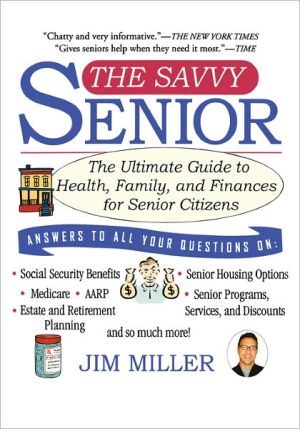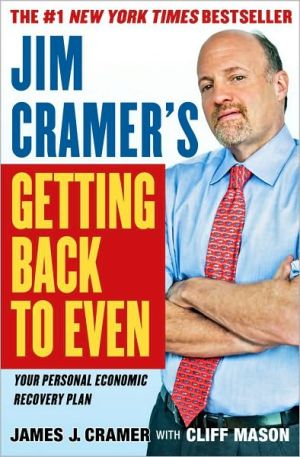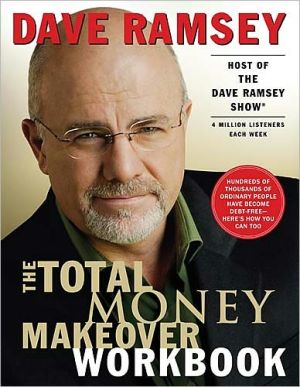The Savvy Senior: The Ultimate Guide to Health, Family, and Finances for Senior Citizens
he Savvy Senior' is a nationally syndicated newspaper column that serves the growing needs of the senior population and the families who support them by providing useful information and valuable resources.While many of the questions focus on Medicare and Social Security, they also cover a wide range of topics, including hearing aids, telemarketing fraud, volunteerism, reverse mortgages, travel, education, wills, nutrition, and even employment.
Search in google:
A concise, helpful resource for seniors that covers topics from aging to investing and travel -- from the popular syndicated newspaper column of the same name."The Savvy Senior" is a nationally syndicated newspaper column that serves the growing needs of the senior population and the families who support them by providing useful information and valuable resources. The column and its companion website (www.savvysenior.org) invite readers to submit their questions and then provide the readers with answers to anything and everything senior. While many of the questions focus on Medicare and Social Security, they also cover a wide range of topics, including hearing aids, telemarketing fraud, volunteerism, reverse mortgages, travel, education, wills, nutrition, and even employment. Now for the first time, all the columns appear together, so that every senior can become "The Savvy Senior." Jim Miller is the creator and writer of "The Savvy Senior" syndicated column. After his parents died, he started writing the column to help himself through the grieving process. Miller lives in Norman, Oklahoma, where he is well known as the stadium announcer for the University of Oklahoma's football and basketball games. Publishers Weekly Those interested in making plans for their own retirement years or concerned about a parent's retirement will find many of their questions answered here. The author writes the syndicated column "The Savvy Senior," which is published in 400 newspapers, and he bases his book on the thousands of questions he receives on social security issues, Medicare, estate and retirement planning, health issues, caregiving, grandparenting and more. Miller's writing style is a mixture of "just the facts, please" and light humor, allowing him to establish himself as a credible and knowledgeable expert. Numerous checklists, resources and charts make it easy to learn about such mundane topics as Medicare and living trusts, while "savvy notes" interspersed between paragraphs enlighten with odd factoids. Baby boomers caring for elderly parents will want to pay special attention to the section on avoiding telemarketing scams to seniors, who are the number one target for this type of criminal activity. And seniors on a fixed income will find the section on "Cost-Cutting Tips on Prescription Drugs" helpful as they learn how to apply for free prescription drugs from the pharmaceutical companies. (June 9) Forecast: The book's title will attract those familiar with Miller's column (it claims to have 18 million readers), and an appearance on The Today Show will tip off new readers. According to Miller, America's senior population will double over the next 25 years. Copyright 2004 Reed Business Information.
-The Basics of Medicare-\ We all know what Medicare is, but do we actually understand it?\ The Medicare program is a federal health-insurance program for people 65 years of age and older, and certain disabled people under age 65. To be eligible for Medicare you must be a U.S. citizen or permanent resident of the United States who is eligible to receive benefits from Social Security.\ Medicare Part A\ Medicare has two parts, Part A and Part B. Medicare Part A (hospital insurance) helps pay for inpatient hospital care, inpatient care in a skilled-nursing facility, home health care and hospice care.\ Savvy Note: The Medicare Part A deductible for inpatient hospital care per benefit period is $876 in 2004, and increases every year. The term "benefit period" is a period of time that begins the day you enter the hospital or skilled-nursing facility and continues until you have been out for 60 consecutive days.\ Medicare Part B\ Medicare Part B (medical insurance) helps pay for doctor services, some preventive services, outpatient hospital and emergency room services, medical equipment and supplies, laboratory services, X-rays, physical therapy, ambulance services and a number of other medical services and supplies that are not covered by Medicare Part A.\ Medicare Cost\ Medicare Part A is free, but Medicare Part B is a voluntary program (which may be refused) and costs $66.60 a month in 2004. Medicare Part B pays 80 percent of services covered under Part B after a $100 deductible.\ Savvy Note: In 2005 the Medicare Part B deductible will increase to $110 and rise yearly afterward.\ Medicare and Nursing-Home Care\ To qualify for Medicare nursing-home benefits you must have been an inpatientin a hospital for at least three days and discharged no more than 30 days before entering the nursing home. A physician must also "certify" that you require skilled-nursing care or rehabilitation that can only be provided in a skilled-nursing facility. If you qualify, Medicare pays 100 percent of the charges for the first 20 days. From day 21 to day 100, the patient must pay $109.50/day while Medicare picks up the difference. After day 100, Medicare pays nothing.\ What Medicare Does Not Cover\ Other medical services and products not covered by Medicare include outpatient prescription drugs, private hospital room, hospital telephone and TV, routine physicals, most dental care, dentures, routine foot care, hearing aids, routine eye care, acupuncture, health care outside the United States and cosmetic surgery.\ Savvy Tip: For detailed information on what Medicare covers in your area, visit the Medicare Coverage Database at www.cms.hhs.gov/med.\ Supplemental Health Care\ It is savvy advice to purchase a Medicare supplemental or Medigap policy (see Medigap Insurance, page 155) at the time you apply for Medicare services. This type of policy (regulated by state insurance departments and sold by many companies) is designed to fill in the health-care expenses not covered by Medicare. Every new Medicare recipient who is age 65 or older has a guaranteed right to buy a Medicare supplement policy. A company cannot reject you for any policy it sells, nor can it charge you more than anyone else your age. You must, however, purchase the supplement policy within the six-month window after enrolling in Medicare Part B for the first time. If you apply for a policy after your six-month period, some companies may refuse coverage for health reasons.\ Savvy Note: If you are age 65 and not eligible for the free Medicare Part A, you can still get it, but you'll have to pay a steep monthly premium. Medicare Part B is also available (for $66.60/month in 2004). You can enroll in Part B without getting Part A, but if you choose to enroll in Part A you are required to get Part B too. For more detailed information on Medicare, visit www.Medicare.gov or call 1-800-633-4227 and order the Medicare & You handbook. This is a free publication that provides great information and is updated every year.\ -The New Medicare Prescription Drug Benefit-\ How will it affect you?\ Containing the most extensive changes to the Medicare program since it began in 1965, the new $400 billion prescription drug benefit will offer some help to its beneficiaries, but how much?\ Currently, Medicare covers 40 million elderly and disabled Americans. Of those, more than 10 million are without any form of prescription drug coverage and 14 million are low-income seniors. Here's a preview of what you can expect from the new prescription drug benefit, which will be known as Medicare Part D. This information was obtained in part from the Department of Health and Human Services and the Associated Press.\ Interim Discount Card\ From June 2004 through 2005 a discount card will be available for Medicare recipients to buy for $30. This card will reduce drug costs by 15 percent or more.\ Medicare Drug Benefit\ Beginning in 2006, Medicare beneficiaries can sign up for a drug plan or join a private health plan that offers drug coverage. Under the Medicare plan, you will be charged a $35-a-month premium per person, or $420 a year. After you pay a $250 deductible, insurance will cover 75 percent of your drug costs up to $2,250. You would thus pay up to $750 out of pocket. (The $250 deductible plus 25 percent of the cost from $251 to $2,250, or $500.) This does not count your $420-a-year premium.\ Coverage Gap\ After you have incurred $2,250 in total drug costs, Medicare will pay nothing more until you have paid $3,600 out of pocket, meaning you would have to pay $2,850 more out of pocket in addition to the $750 already paid. This does not count your $420 annual premium.\ Catastrophic Coverage\ When your out-of-pocket spending reaches $3,600, you will pay 5 percent of the cost of each prescription. Medicare pays the other 95 percent.\ Savings Chart\ The following chart shows how more than 25 million seniors, mostly middle income, will fare under the 2006 Medicare prescription drug benefit. Another 14.1 million lower-income seniors, including those eligible for Medicaid, will fare better.\ Note: You Pay is your total out-of-pocket expense, which includes the $420 annual premium, the $250 deductible and the 25 percent additional costs based on a complex formula. Catastrophic coverage is also figured into the formula.\ Savvy Tip: You will have to spend at least $810 a year on prescription drugs to benefit from the Medicare prescription drug benefit. That's because you'll spend more on your premium ($420), deductible ($950) and 25 percent out-of-pocket drug costs than you'll get back in Medicare coverage.\ Limited-Income Subsidies\ In 2004 and 2005, low-income recipients earning less than $12,124 a year, or $16,363 for married couples, will receive an annual subsidy of $600 credited to their drug discount card to help defray drug costs.\ Beginning in 2006, people eligible for Medicaid and Medicare will pay no premium or deductible and have no gap in coverage. They will pay $1 per prescription for generics and $3 for brand names. Copays are waived for those in nursing homes.\ Members with limited income below the federal poverty line -- around $13,000 for individuals and $17,600 for couples, with assets under $6,000 for individuals and $9,000 for couples -- will be entitled to different benefits: They will pay no premium or deductible, nor will they face a gap in coverage. For generic drugs there is a $2 copay and a $5 copay for all other drugs, up to the out-of-pocket limit.\ Members with savings and incomes below the federal poverty level -- between $13,000 and $14,400 for individuals and $17,600 and $19,500 for couples, with assets under $10,000 for individuals and $20,000 for couples -- will be entitled to the following benefits: a monthly premium based on a sliding scale; a $50 deductible; no gap in coverage; coinsurance of 15 percent, up to the out-of-pocket limit; and copayments of either $2 or $5 after reaching the out-of-pocket expense limit.\ Savvy Tip: For people already in Medicare, open enrollment for the prescription drug coverage will begin November 15, 2005, and run through May 15, 2006. The benefits are scheduled to begin January 1, 2006.\ Retiree Coverage\ Tax-free subsidies, worth more than $70 billion over 10 years, will be provided to employers who maintain drug coverage for retirees once the Medicare drug benefit begins in 2006. But some employers may still drop their drug coverage. You'll need to check!\ Generic Drugs\ The ability of pharmaceutical companies to block cheaper equivalents will be limited, which should help speed generic drugs to the market.\ Drugs from Canada\ The ban on importing prescription drugs from abroad will be maintained, but such drugs will be allowed from Canada if the Department of Health and Human Services certifies their safety, which the department has thus far refused to do. Also, a study of safety issues will be authorized.\ Other Changes to Medicare\ Doctors' Services and Other Out-of-Hospital\ (Part B) Coverage\ Premium\ People with incomes greater than $80,000 a year will pay a larger Part B premium for doctors' services and outpatient care. The size of the premium will increase with income, roughly tripling for people with an income over $200,000.\ Deductible\ The deductible will rise from $100 to $110 in 2005, and thereafter will be indexed to the growth in Part B spending.\ New Benefits\ Medicare will cover an initial physical examination for new beneficiaries and screening for diabetes and cardiovascular disease. It will provide benefits for coordinated care for people with chronic illnesses and will increase payments for doctors administering mammograms to encourage their use.\ Health Savings Accounts\ People under age 65 with high-deductible health-insurance policies -- $1,000 a year for individuals, $2,000 for couples -- will be allowed to shelter income from taxes by depositing a certain amount of money in health savings accounts. Investors will receive a tax deduction and pay no taxes on the investment and earnings upon withdrawal, provided the money is used for health expenses; otherwise, a 10 percent penalty will apply. Talk to your health-insurance provider for more information on health savings accounts.\ Rural Health\ Medicare payments to rural hospitals and doctors, among others, will be increased by $25 billion over 10 years.\ Hospital Payments\ Hospitals can avoid future cuts in payments by submitting data on the quality of care to the federal agency that runs the Medicare program. At the same time, payments through Medicaid to hospitals that serve a large number of disadvantaged patients will increase. An 18-month pause in the development of new specialty hospitals will be imposed, and there will be a limit on the expansion of existing ones.\ Physician Payments\ Doctors will receive increases of 1.5 percent per year in Medicare payments for 2004 and 2005.\ Home Health Care\ Payments to home health agencies will be cut, but copayments from patients will not be required.\ The New Role of Private Companies\ Private firms will administer the new drug benefit on a regional basis. It will provide $12 billion in subsidies to private insurers that choose to offer basic health insurance. Those insurers include preferred provider organizations (PPOs), which encourage use of certain doctors but allow patients to go elsewhere if they pay extra, and private fee-for-service plans, which allow patients to see any doctor.\ Savvy Note: Medicare Advantage will replace Medicare + Choice, the current managed-care program, in 2006.\ Medigap Change\ Starting in 2006, Medicare beneficiaries who enroll in the new drug plan will not be allowed to buy Medigap policies to help defray drug costs. However, those people who choose to forgo the new Medicare drug benefit can renew their Medigap drug benefit policy.\ 2010 Competition\ Starting in 2010, Medicare will test competition between private health plans and the government. The experiment will involve up to 2 million seniors in six metropolitan areas for six years. Affected seniors might have to pay 5 percent more a year to stay in Medicare if private insurers offer cheaper coverage.\ Savvy Tip: To help you better understand the new Medicare reform changes and prescription drug benefit, call your local health-insurance counseling program (SHIP). Call 1-800-633-4227 to get your local number. Also see Health-Insurance Help on page 164.\ -Medicare + Choice Plan-\ Are you ready to experience the Medicare alphabet in a whole new way? There is Medicare Part A, Part B, and now C, also called the Medicare + Choice Plan.\ Congress created the Medicare + Choice program to provide you with more choices and sometimes extra benefits by letting private companies offer you your Medicare benefits.\ Original Medicare Plan\ It's important to be clear on the Original Medicare Plan, also known as Medicare Part A and B, because this will affect your Medicare + Choices. Simply put, Part A is the hospital insurance, and Part B, referred to as medical insurance, helps pay for doctor visits or medical equipment that you may need. At age 65 (if eligible), you automatically get Part A when you sign up for Medicare, although Part B is optional. If you sign up for Part B, you pay a monthly premium, but if you don't, you won't be eligible for Medicare + C.\ Think C, for Choice\ Medicare + Choice is offered by private companies that contract with the Medicare program to offer services. It is still part of Medicare, and depending on your circumstances and where you live, it certainly may be worth a look.\ Medicare + Choice plans include\ --Medicare managed-care plans (like HMOs), and\ --Medicare private fee-for-service plans.\ \ The real advantage of Medicare + Choice is that it goes beyond traditional Medicare coverage. It may pay for a general annual physical, for example, or for prescription drugs, which are not covered under traditional Medicare (A and B). And while there is a monthly premium, there may be lower out-of-pocket costs with such things as deductibles and copays. But Medicare + Choice options are not offered everywhere, and while there are some limited fee-for-service packages available, most Medicare + Choice programs are managed-care plans like HMOs, PPOs, PSOs and PFFS, in which the patient/member agrees to receive care from specific doctors, hospitals and others -- called a network -- in exchange for reduced overall health-care costs. That's the part of the plan that many people don't like, especially if it means they can no longer continue to see their own doctor or use the hospital of their choice. But your doctor may already participate in a plan for your area. You'll have to check.\ Copyright © 2004 Jim Miller
AcknowledgmentsxiIntroductionxiiiLifestyleDriver Safety Program3Senior Transportation5Utility Assistance8Volunteerism11Senior Employment14Telemarketing Fraud16Identity Theft19Visiting Grandchildren21Grandparenting from Afar23Financial Tips for Grandparents Raising Grandchildren25Money-Managing Grandparents28The 529 Plan30Traveling with Your Grandchildren32Genealogy 10135Become a Computer-Savvy Senior39HomeHome Modification45Fall Prevention47Gadgets for Seniors49Downsizing52Senior Living Options54Assisted-Living Facilities57Continuing-Care Retirement Communities59Alternatives for Senior Care62Choosing a Nursing Home Wisely64Ombudsmen68Intergenerational Living71Long-Distance Caregiving73Geriatric-Care Manager75Alzheimer's Caregivers78HealthSenior Eye Care83Stroke Signs85Subtle Heart-Attack Symptoms88CRP Test90Alzheimer's and Other Forms of Dementia92Arthritis and Exercise95Remember Your Flu Shot97Hearing Loss99Incontinence101Macular Degeneration104Osteoporosis107Teeth, Gums and Heart110Prostate Checkups112Senior Insomnia115Post-Retirement Blues117Men and Grief119Senior Nutrition121Second Opinions123Weight-Training Seniors125End-of-Life Decisions127Funeral Ready129Medicare and MoreThe Basics of Medicare139The New Medicare Prescription Drug Benefit141Medicare + Choice Plan146Medicare Enrollment149Appealing Medicare152Medigap Insurance155Medicare Preventive Services158Hospice Care and Medicare159Home Health Care162Health-Insurance Help164Medicaid and Nursing-Home Care166Medicare Fraud169Cost-Cutting Tips on Prescription Drugs171Social SecuritySocial Security Retirement Basics185Social Security Age Hike189Social Security Benefits: Now or Later?191Survivors Benefits194Divorced Benefits196Divorced Widows and Widowers Benefits197How Work Affects Social Security199Social Security Benefits and Taxes201Social Security Disability203Social Security Appeals205SSI207Notch Notes209FinancesFinancial Tips for Retirement213Choosing a Financial Planner215401(k) Retirement Options218IRA Savvy220Health-Insurance Options Before Medicare223Senior Legal Services225Free Tax Preparation227Get a Will229Living Trusts232Reverse Mortgages235Long-Term-Care Insurance241Senior Debt245
\ Publishers WeeklyThose interested in making plans for their own retirement years or concerned about a parent's retirement will find many of their questions answered here. The author writes the syndicated column "The Savvy Senior," which is published in 400 newspapers, and he bases his book on the thousands of questions he receives on social security issues, Medicare, estate and retirement planning, health issues, caregiving, grandparenting and more. Miller's writing style is a mixture of "just the facts, please" and light humor, allowing him to establish himself as a credible and knowledgeable expert. Numerous checklists, resources and charts make it easy to learn about such mundane topics as Medicare and living trusts, while "savvy notes" interspersed between paragraphs enlighten with odd factoids. Baby boomers caring for elderly parents will want to pay special attention to the section on avoiding telemarketing scams to seniors, who are the number one target for this type of criminal activity. And seniors on a fixed income will find the section on "Cost-Cutting Tips on Prescription Drugs" helpful as they learn how to apply for free prescription drugs from the pharmaceutical companies. (June 9) Forecast: The book's title will attract those familiar with Miller's column (it claims to have 18 million readers), and an appearance on The Today Show will tip off new readers. According to Miller, America's senior population will double over the next 25 years. Copyright 2004 Reed Business Information.\ \ \ \ \ "A good, important column that is full of information and resources." (Patricia St. Louis, The Fountain Valley News, Fountain, Colorado)\ \








